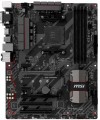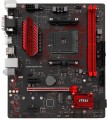Form factor
The form factor of the motherboard determines, first of all, its physical dimensions, and, accordingly, a number of parameters directly related to them: type of computer case, installation method, type of power connector, number of slots for additional boards (expansion slots), etc. At the moment, there are such main form factors of motherboards:
—
ATX. One of the most common form factors for PC motherboards. The standard size of such a board is 30.5x24.4 cm, it has up to 7 expansion slots and a 24-pin or (less often, in older models) 20-pin power connector.
—
Micro-ATX. A slightly reduced version of the ATX form factor, with more compact dimensions (usually 24.4x24.4 cm) and, accordingly, fewer places for peripherals — there are usually only two slots for "RAM", expansion slots — from two to four. Nevertheless, despite the limited size, such boards can be intended for quite powerful systems.
—
Mini-ITX. Motherboards of compact dimensions (17x17 cm). Designed for use primarily in small form factor computers (small form factor, SFF), in other words, compact PCs. According to the mounting specifications and the location of connectors and slots, they are compatible with ATX standard cases. They usually have one expansion slot.
—
mini-STX. Another representative of compact form factors, assuming a boar
...d size of 140x147 mm. Thus, the overall size is almost a third smaller than mini-ITX. At the same time, such motherboards often have seats for fairly powerful processors (for example, the LGA 1151 socket for Intel Core chips) and are made based on the corresponding TDP values. But expansion slots, usually, are absent.
— micro DTX. A relatively new compact form factor, which is not common, mainly among rather specific motherboards — in particular, models designed for cases in the PIO form factor. This form factor is characterized by a very small size and weight and allows you to mount the case directly behind the monitor, on a standard VESA mount. One of the features of "motherboards" for such systems is that the graphics card is installed along the board, and not perpendicularly — accordingly, the PCI-E 16x connector (see below) has a non-standard location. At the same time, micro-DTX boards are similar in terms of fasteners to microATX and can be used in cases of the corresponding form factor (except that additional equipment may be required for the correct installation of a graphics card). The standard size of such a board is 170 x 170 mm, similar to mini-ITX.
— mini DTX. An intermediate format between the microDTX described above and the original DTX; sometimes also described as an extended mini-ITX version. It has a standard size of 170 x 203 mm and can be equipped with two expansion slots (mini-ITX and mini-DTX have one such slot); it is completely similar in application — it is intended mainly for compact cases, in particular, HTPC computers.
— XL-ATX. Larger version of the ATX form factor. While not yet a common standard, size options include 32.5x24.4cm with 8 expansion slots and 34.3x26.2cm with up to 9 expansion slots.
— Thin mini-ITX. A “thin” version of the reduced mini-ITX form factor described above: according to the official specification, the total thickness of the thin mini-ITX board should not exceed 25 mm. Also designed for the most miniature computers — in particular, HTPC.
— E-ATX. The letter E in the name of this form factor stands for "Extended" — extended. True to its name, E-ATX is another enlarged version of ATX using 30.5x33cm boards.
— EEB. Full name SSI EEB. The form factor used in server systems (see “By direction”) provides a board size of 30.5x33 cm.
— CEB. The full name is SSI CEB. Another form factor of "server" motherboards. In fact, it is a narrower version of the EEB described above, with a width reduced to 25.9 cm (with the same height of 30.5 cm).
— flex-ATX. One of the compact variations of ATX, which provides board dimensions of less than 229x191 mm, as well as less than 3 expansion slots. At the same time, in terms of the location of the mounting holes, this standard is identical to microATX; in fact, it was developed as a potential replacement for the latter, but for a number of reasons it did not receive much distribution, although it continues to be produced.
— Non-standard (Custom). The name Proprietary is also used. Motherboards that do not conform to standard form factors and are designed for cases of special sizes (usually branded ones).Size (HxW)
Motherboard dimensions in height and width. It is assumed that the traditional placement of motherboards is vertical, so in this case one of the dimensions is called not the length, but the height.
Motherboard sizes are largely determined by their form factors (see above), however, the size of a particular motherboard may differ slightly from the standard adopted for this form factor. In addition, it is usually easier to clarify the dimensions according to the characteristics of a particular motherboard than to look for or remember general information on the form factor. Therefore, size data can be given even for models that fully comply with the standard.
The third dimension — thickness — is considered less important for a number of reasons, so it is often omitted.
DDR4
The number of slots for DDR4 memory sticks provided in the motherboard.
DDR4 is a further (after the third version) development of the DDR standard, released in 2014. Improvements compared to DDR3 are traditional — an increase in operating speed and a decrease in power consumption; The volume of one module can be from 2 to 128 GB. It is this RAM standard that most modern motherboards are designed for; the number of slots for DDR4 is usually
2 or
4, less often —
6 or more.
Max. memory
The maximum amount of RAM that can be installed on the motherboard.
When choosing according to this parameter, it is important to take into account the planned use of the PC and the real needs of the user. So, volumes
up to 32 GB inclusive are quite enough to solve any basic problems and run games comfortably, but without a significant reserve for an upgrade.
64 GB is the optimal option for many professional use cases, and for the most resource-intensive tasks like 3D rendering,
96 GB or even
128 GB of memory will not be a limit. The most “capacious” motherboards are compatible with volumes of
192 GB or
more - they are mainly top-end solutions for servers and HEDT (see “In the direction”).
You can choose this parameter with a reserve – taking into account a potential RAM upgrade, because installing additional RAM sticks is the simplest way to increase system performance. Taking this factor into account, many relatively simple motherboards support very significant amounts of RAM.
PCI-E 4x slots
Number of PCI-E (PCI-Express) 4x slots installed on the motherboard.
The PCI Express bus is used to connect various expansion cards — network and sound cards, video adapters, TV tuners and even SSD drives. The number in the name indicates the number of PCI-E lines (data transfer channels) supported by this slot; the more lines, the higher the throughput. 4 PCI-E lanes provide data transfer speeds of about 4 GB/s for PCI-E version 3.0 and 8 GB/s for version 4.0 (for more information about the versions, see "PCI Express Support").
The general rule for PCI-E is this: the card must be connected to a slot with the same or more lanes. Thus, boards for 1 or 4 PCI Express lanes can be installed in a standard PCI-E 4x slot. However, it is worth noting that in the design of modern "motherboards" there are slots of increased sizes — in particular, PCI-E 4x, corresponding in size to PCI-E 16x. The type of such slots in our catalog is indicated by the actual throughput, that is, the mentioned example will also be counted as PCI-E 4x. At the same time, peripherals with 16 PCI-E channels can also be physically connected to this connector — however, you should make sure that the throughput will be sufficient for the normal operation of such peripherals.
PCI slots
The number of PCI slots provided in the design of the motherboard.
These slots are used for expansion cards. At the same time, technically, this interface is considered obsolete — in particular, it is noticeably inferior to the newer PCI-E in terms of data transfer speed (up to 533 MB / s). Nevertheless, for some types of components (for example, sound cards), such features are quite enough; and the use of PCI allows you to leave free PCI-E slots that may be needed for more demanding peripherals. So even nowadays, both motherboards with PCI slots and components with such a connection can still be found on the market.
Audiochip
The model of the audio chip (a module for processing and outputting sound) installed on the motherboard. Data on the exact name of the sound chip will be useful when looking for detailed information about it.
Modern "motherboards" can be equipped with fairly advanced audio modules, with high sound quality and extensive features, which makes them suitable even for gaming and multimedia PCs (although professional audio work will still most likely require a separate sound card). Here are the most popular modern audio chips:
Realtek ALC887,
Realtek ALC892,
Realtek ALC1150,
Realtek ALC1200,
Realtek ALC1220,
Realtek ALC4050,
Realtek ALC4080,
Supreme FX.
USB 3.2 gen2
The number of native USB 3.2 gen2 connectors provided on the back of the motherboard. In this case, we mean traditional, full-size USB A ports.
USB 3.2 gen2(formerly known as USB 3.1 gen2 and simply USB 3.1) is the evolution of USB 3.2 after version 3.2 gen1 (see above). This standard provides connection speeds up to 10 Gbps, and to power external devices in such connectors, USB Power Delivery technology (see below) can be provided, which allows you to output up to 100 W per device (however, Power Delivery support is not mandatory, its presence should be specified separately). Traditionally for the USB standard, this interface is backwards compatible with previous versions — in other words, you can easily connect a device supporting USB 2.0 or 3.2 gen1 to this port (unless the speed will be limited by the capabilities of a slower version).
The more connectors provided in the design, the more peripheral devices can be connected to the motherboard without the use of additional equipment (USB splitters). In some models of motherboards, the number of ports of this type is
5 or even more. At the same time, we note that in addition to the connectors on the rear panel, connectors on the board itself (more precisely, ports on the case connected to such connectors) can also provide a USB connection. See below for more on this.
Fan power connectors
The number of connectors for powering coolers and fans provided in the motherboard. A processor cooler is usually connected to such a connector, and fans of other system components — video cards, cases, etc. can also be powered from the "motherboard"; sometimes it is more convenient than pulling power directly from the PSU (at least you can reduce the number of wires in the case). Many modern boards are equipped with
4 or more connectors of this type.

